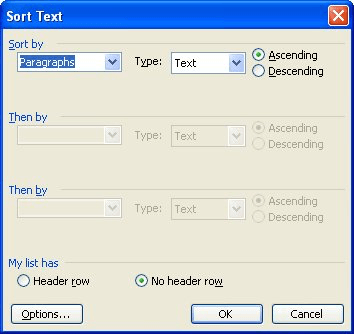Please Note: This article is written for users of the following Microsoft Word versions: 97, 2000, 2002, and 2003. If you are using a later version (Word 2007 or later), this tip may not work for you. For a version of this tip written specifically for later versions of Word, click here: Sorting by Headings.
Written by Allen Wyatt (last updated February 6, 2021)
This tip applies to Word 97, 2000, 2002, and 2003
A useful trick you can use when developing some types of documents is the ability to sort the various parts of the document based on the headings you use. For instance, you can sort the document based on first-level headings (paragraphs that use the Heading 1 style) by following these steps:

Figure 1. The Sort Text dialog box.
Had you skipped the first two steps and performed the sort in any view besides Outline view, every paragraph would have been sorted alphabetically and therefore rearranged so that subordinate paragraphs would be separated from their headings. In other words, you would have a mess. However, in Outline view, the highest-level headings are sorted, bringing along the subordinate heading levels and body text.
If you wanted to sort by Heading 2 paragraphs, you should also use Outline view, but you would have to first select all the Heading 2 paragraphs subordinate to a particular Heading 1 paragraph and then sort. You will get the same results regardless of how many heading levels that you show on the Outline toolbar.
WordTips is your source for cost-effective Microsoft Word training. (Microsoft Word is the most popular word processing software in the world.) This tip (41) applies to Microsoft Word 97, 2000, 2002, and 2003. You can find a version of this tip for the ribbon interface of Word (Word 2007 and later) here: Sorting by Headings.

Do More in Less Time! An easy-to-understand guide to the more advanced features available in the Microsoft 365 version of Word. Enhance the quality of your documents and boost productivity in any field with this in-depth resource. Complete your Word-related tasks more efficiently as you unlock lesser-known tools and learn to quickly access the features you need. Check out Microsoft 365 Word For Professionals For Dummies today!
Word has a very orderly way in which it sorts information, but that orderly method may not meet what you need to have ...
Discover MoreWhen sorting information, Word follows some pretty strict rules. If you want to modify how those rules are applied, you ...
Discover MoreWord allows you to easily sort the information you store in a document. If you want to sort information as groups of ...
Discover MoreFREE SERVICE: Get tips like this every week in WordTips, a free productivity newsletter. Enter your address and click "Subscribe."
There are currently no comments for this tip. (Be the first to leave your comment—just use the simple form above!)
Got a version of Word that uses the menu interface (Word 97, Word 2000, Word 2002, or Word 2003)? This site is for you! If you use a later version of Word, visit our WordTips site focusing on the ribbon interface.
Visit the WordTips channel on YouTube
FREE SERVICE: Get tips like this every week in WordTips, a free productivity newsletter. Enter your address and click "Subscribe."
Copyright © 2025 Sharon Parq Associates, Inc.
Comments